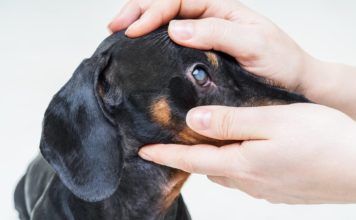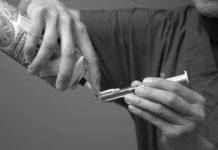Are rawhide chews safe for dogs?
[From Tufts October 2010 Issue]Ive been subscribing to your newsletter for many years now. Its always got great information, and I save old editions just in case I have a question later. Id like to have a definitive answer, if possible, on the safety of rawhide treats. My dogs (we have four right now, all 85 pounds or more) have always loved them, but I kept reading and hearing about dangers of them, so I switched to pork treats.
The Trick to Giving Your Dog Liquid Medicine Via Oral Syringe
Restoring a dogs health requires a partnership between owner and veterinarian. The veterinarian selects the appropriate medicine and relies on the owner to give the medicine in the correct dose at the right time for the full duration. Far too often, the medicine stays in the refrigerator or the medicine cabinet because an owner lacks the confidence to administer it or tires of struggling with his dog to accept the medicine.
Bernie the Bernese mountain dog
[From Tufts December 2010 Issue] This is the first of an occasional column by best-selling author Nicholas Dodman, BVMS, DACVB, director of the Animal Behavior Clinic at Cummings School. When Bernie was first brought to see me, he was 2 years, 10 months old. His owner, a charming older woman living alone, clearly doted on Bernie. A castrated male, Bernie was first acquired by the woman from a breeder when he was 8 weeks of age. He…
Similar-looking conditions affect the muzzle
[From Tufts January 2011 Issue] Its easy to spot problems with the muzzle - the dogs snout - because the signs are readily discernible. The skin or nose may exhibit depigmentation, ulcers, scaling, itchiness or redness. The muzzle includes the nasal planum, or nose; the nasal cavity, or interior of the muzzle; and the skin and bone overlying the nasal cavity. Diseases of the nasal cavity are usually associated with sneezing, bleeding and discharge from the nostrils.…
This Dog Has Serious ‘Tissue Issues’
Our dog, Legolas, a Lagotto Romagnolo, is obsessed with eating paper. If you leave a juicy filet mignon unattended on the table, our dog will make a swoop and steal the napkin. If you try to blow your nose in his presence, he might just take your nose off trying to snatch the tissue. Does he have some diet deficiency? Patty Wendel Cold Spring Harbor, N.Y. …
Three simple steps to modify fear aggression – you start with a beardless...
[From Tufts February 2011 Issue] My favorite approach to modifying fear aggression is counter conditioning and desensitization. Theyre often the easiest for dog owners to practice on their own without the constant presence of an assistant to help them. They work to change your dogs association with an aversive stimulus from negative to positive by pairing it with something wonderful. …
Get Your Leash
Teach It: Your dog will fetch his leash from its regular spot, either upon your command or whenever he wants to go for a walk. 1. Introduce the word leash to your dog by using it each time you put it on him. Toss his leash playfully and tell him to fetch leash." Youll want to secure the metal clasp within the leash so your dog doesnt bonk himself in the head with it in his exuberance!…
Turn Off the Light
Teach It:Your dog will learn to paw a light switch on the wall, turning the lights on or off. A flat, rocker light switch is easiest, especially for flipping the switch to the up position. Small dogs may require a stool placed under the switch. 1. Hold a treat against the wall a little above the light switch and encourage your dog with lights, get it! Let him have the treat when he is able to…
Shake Hands – Left and Right
Teach It: When shaking hands, your polite pooch raises his paw to chest height, allowing guests to shake his paw. This skill is taught for both paws. 1. With your dog sitting before you, hide a treat in your right hand, low to the ground. Encourage your dog to paw at it by saying get it and Shake. Reward your dog with the treat the moment his left paw comes off the ground. …
Ticks lie in wait in vegetation for dogs to brush by
Warm weather is prime season for ticks. The parasites can transmit infectious disease, such as Lyme disease and Rocky Mountain spotted fever, or even paralysis, because of a toxin in their salvia.
We asked Michael Stone, DVM, board-certified in small animal medicine at Cummings School of Veterinary Medicine at Tufts University, how owners can protect their dogs from ticks. His response:
Unfortunately, tick control is more difficult than flea control. Even with the use of anti-tick products, youll still find an occasional tick on your dogs coat. Adult ticks most commonly migrate to the ears, around the neck and between the toes.
You see a dog left in car on a hot day
[From Tufts August 2010 Issue] Its a hot summer day, and you return to your car after shopping at the mall. As you look for your keys, you glance at the car next to you and see a dog inside, panting, obviously in distress. What should you do? First and foremost, a concerned citizen should try to find the owner of the vehicle, says animal law attorney Jonathan Rankin, a graduate of Tufts Universitys Master of Science…
Does Your Dog Snore? It May Be A Cause for Concern
Snoring has been an age-old problem in dogs and people. In both instances, it can be a harmless nuisance or a sign of an anatomical problem. In most cases, a dogs snoring is not a major cause for alarm, says Elizabeth Rozanski, assistant professor of emergency and critical care at Cummings School of Veterinary Medicine at Tufts University. The key is to determine what is considered normal for your dog."








